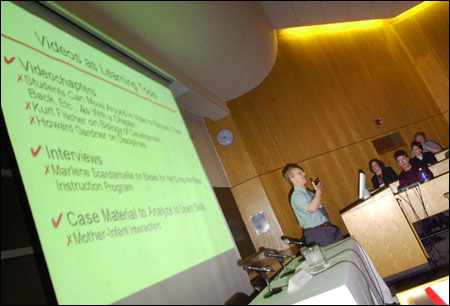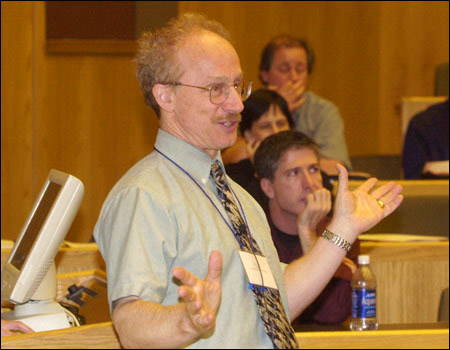Extending class into cyberspace:
In search of synergy: Annual workshop highlights innovative uses of technology in teaching

In January 2002, former Medical School Executive Dean for Administration Paul Levy took over as president and chief executive officer of ailing Beth Israel Deaconess Medical Center, which had been losing $50 to $60 million a year.
Two weeks later, Levy sat down in front of a Harvard Business School video camera to begin taping an extraordinarily candid – and extraordinarily current – video backbone of a new multimedia digital case to be used in the Business School’s MBA program.
Professor of Business Administration David Garvin said Levy sat before the cameras every two to four weeks for the first six months he was at Beth Israel Deaconess, offering his view of events during a turbulent time at an institution he was hired to turn around.
After taping a few interviews, Levy offered to augment the video content with selected e-mail correspondences, so students could get a better idea of the communications he was having each day. Levy was also open to including his personal calendar for those months, as well as selected internal memoranda and reports, Garvin said.
All compiled, Garvin said, the material presents a remarkably thorough case study of Levy’s experiences taking over Beth Israel Deaconess, which has lowered its losses but is yet to turn a profit.
Garvin said they designed Levy’s case study to respond to a flaw of traditional paper cases used in case-based teaching. The cases, he said, are often written years after events unfold and, consequently, often consist mostly of the public details of what happened. Often lost, he said, are behind-the-scenes activity, thoughts, and opinions of people at the time. It is often those day-to-day and hour-to-hour details, he said, that can be most instructive to students.
Garvin was just one of several presenters Wednesday (May 21) at the annual “Workshop on the Use of Technology In Teaching and Learning at Harvard University.” The workshop, sponsored by the Provost’s Office and by the Harvard Academic Computing Committee, provides a chance for faculty, staff, and students to meet and exchange ideas about ways to best employ technology in teaching and learning.
Assistant Provost for IT and Chief Information Officer Dan Moriarty opened the workshop, which took place at Harvard Business School’s Aldrich Hall. Moriarty said over its five years, the workshop has reflected the progress and pace on campus of integrating technology in learning.
Early sessions, he said, focused on technology and the Web. The focus shifted then to new software and software toolkits to enable new uses and activities. Next came a focus on using technology, such as animation, to teach what are traditionally the most difficult concepts in classes each year.
This year’s focus, he said, is on how technology can change teaching in the classroom.

Garvin was just one of three speakers at a morning series of faculty presentations. He was joined by Professor of Education Kurt Fischer, who discussed how, in his Graduate School of Education class on “Cognitive Development, Education and the Brain,” teaching has changed since they began videotaping lectures for students to view before class and devoting class time to discussions.
“It’s been a delight to the team how interactive the class is,” Fisher said.
Assistant Professor of Neuroscience Jim Quattrochi also described ICON, an interactive case-based online network that presents medical cases for students to work through. ICON is interactive in that faculty play the roles of certain characters in the cases, helping to guide students by presenting symptoms, test results, and other clues along the way. The content, however, is up to the students to generate as they research and discuss a case’s particulars.
“What we tried to achieve here is a synergy, a synergy between faculty and students in student learning,” Quattrochi said.
Demonstrations of different projects followed the presentations, including one of The Library Digital Initiative, which has, over the past five years, used the combined efforts of libraries across Harvard to build an infrastructure for digital content. Another demonstration project was Teaching Across the World, an HBS course taught by Michael Porter that uses online video to teach at 18 universities around the world. The audience for the project includes more than 900 students on five continents.
Other demonstration projects included Negotiations Using Instant Messenger, stemming from a Kennedy School of Government course on negotiation where instant messenger is used to conduct online negotiations, and an interactive online module developed for students of Japanese to improve their auditory skills, called East Asian Language Modules.




